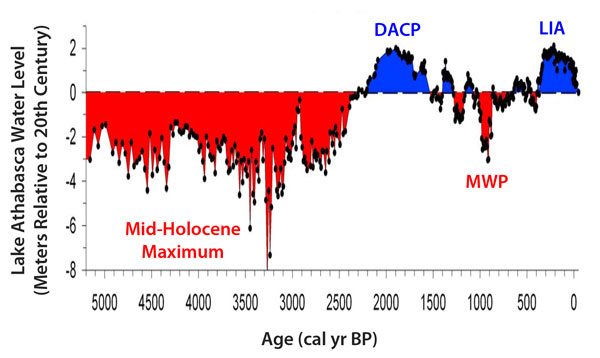Volume 14, Number 39: 28 September 2011
In a study recently published in Geophysical Research Letters, Wolfe et al. (2011) write that the level of Canada's Lake Athabasca -- North America's ninth-largest lake located in the northwest corner of Saskatchewan and the northeast corner of Alberta between 58° and 60° N -- "is a sensitive monitor of climate-driven changes in streamflow from alpine catchments draining the eastern slopes of the Rocky Mountains (Wolfe et al., 2008; Johnston et al., 2010; Sinnatamby et al., 2010)," and that "paleoenvironmental data indicate that the last millennium was punctuated by multi-decadal episodes of both higher and lower Lake Athabasca levels relative to the 20th century mean, which corresponded with fluctuations in the amount and timing of runoff from glaciers and snowpacks (Wolfe et al., 2008)." In addition, they say that "the highest levels of the last 1000 years occurred c. 1600-1900 CE [=AD] during the Little Ice Age (LIA), in company with maximum late-Holocene expansion of glaciers in the Canadian Rockies," while at the other end of the spectrum they state that the "lowest levels existed at c. 970-1080 CE at a time of low glacier volume," near the midpoint of the global Medieval Warm Period (MWP), as illustrated in the Interactive Map and Time Domain Plot of our Medieval Warm Period Project.
In their newest study of the subject, the four Canadian researchers expanded the time span of the lake-level history to the past 5200 years, based on new analyses of sediment cores they collected in July of 2004 from North Pond (a lagoon on Bustard Island located at the western end of Lake Athabasca); and in doing so they discovered (see the figure below) that "modern society in western Canada developed during a rare interval of relatively abundant freshwater supply -- now a rapidly diminishing by-product of the LIA glacier expansion, which is in agreement with late 20th century decline in Athabasca River discharge identified in hydrometric records (Burn et al., 2004; Schindler and Donahue, 2006)." And, frightenly, their data suggest, as they describe it, that "the transition from water abundance to scarcity can occur within a human lifespan," which, as they caution, "is a very short amount of time for societies to adapt."

The Reconstructed water level history of Lake Athabasca. Adapted from Wolfe et al. (2011).
The data in the figure above also suggest that the peak warmth of the Medieval Warm Period -- which was unrelated to any change in the atmosphere's CO2 content -- was likely significantly greater than the peak warmth that has been experienced to date during the Current Warm Period. And the rapidly declining water level over the last couple of decades -- when earth's temperature was near its modern peak, but exhibited very little trend -- suggests that lake level could continue its rapid downward course if planetary temperatures merely maintain their current values. And, therefore, Wolfe et al. conclude, in the final sentence of their report, that "as consumption of water from rivers draining the central Rocky Mountain region is on an increasing trend, we must now prepare to deal with continental-scale water-supply reductions well beyond the magnitude and duration of societal memory."
Sherwood, Keith and Craig Idso
References
Burn, D.H., Abdul Aziz, O.I. and Pictroniro, A. 2004. A comparison of trends in hydrological variables for two watersheds in the Mackenzie River Basin. Canadian Water Resources Journal 29: 283-298.
Johnston, J.W., Koster, D., Wolfe, B.B., Hall, R.I., Edwards, T.W.D., Endres, A.L., Martin, M.E., Wiklund, J.A. and Light, C. 2010. Quantifying Lake Athabasca (Canada) water level during the Little Ice Age highstand from paleolimnological and geophysical analyses of a transgressive barrier-beach complex. The Holocene 20: 801-811.
Schindler, D.W. and Donahue, W.F. 2006. An impending water crisis in Canada's western prairie provinces. Proceedings of the National Academy of Sciences USA 103: 7210-7216.
Sinnatamby, R.N., Yi, Y., Sokal, M.A., Clogg-Wright, K.P., Asada, T., Vardy, S.H., Karst-Riddoch, T.L., Last, W.M., Johnston, J.W., Hall, R.I., Wolfe, B.B. and Edwards, T.W.D. 2010. Historical and paleolimnological evidence for expansion of Lake Athabasca (Canada) during the Little Ice Age. Journal of Paleolimnology 43: 705-717.
Wolfe, B.B., Edwards, T.W.D., Hall, R.I. and Johnston, J.W. 2011. A 5200-year record of freshwater availability for regions in western North America fed by high-elevation runoff. Geophysical Research Letters 38: 10.1029/2011GL047599.
Wolfe, B.B., Hall, R.I., Edwards, T.W.D., Jarvis, S.R., Sinnatamby, R.N., Yi, Y. and Johnston, J.W. 2008. Climate-driven shifts in quantity and seasonality of river discharge over the past 1000 years from the hydrographic apex of North America. Geophysical Research Letters 35: 10.1029/2008GL036125.




